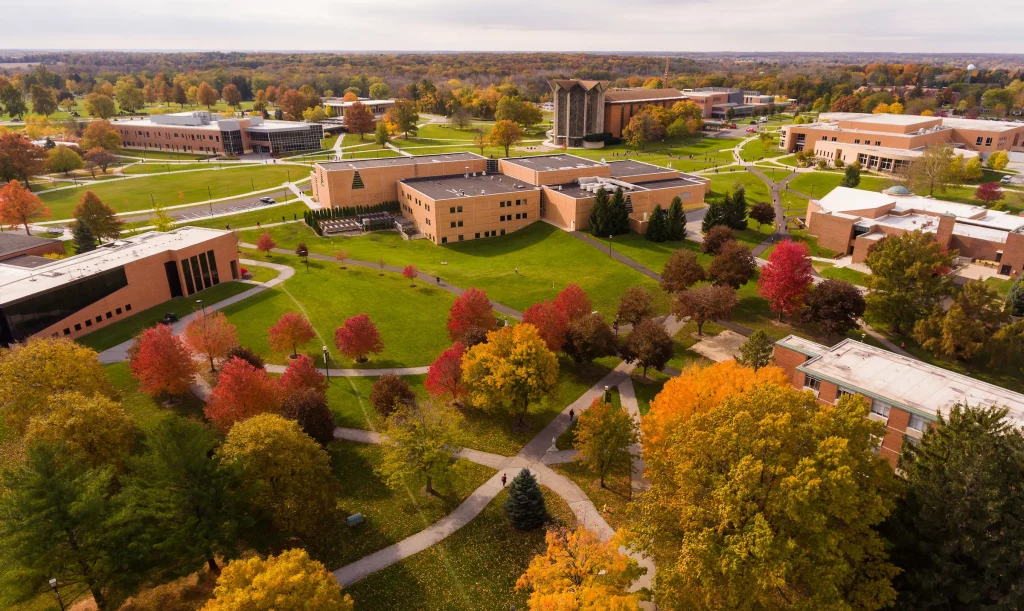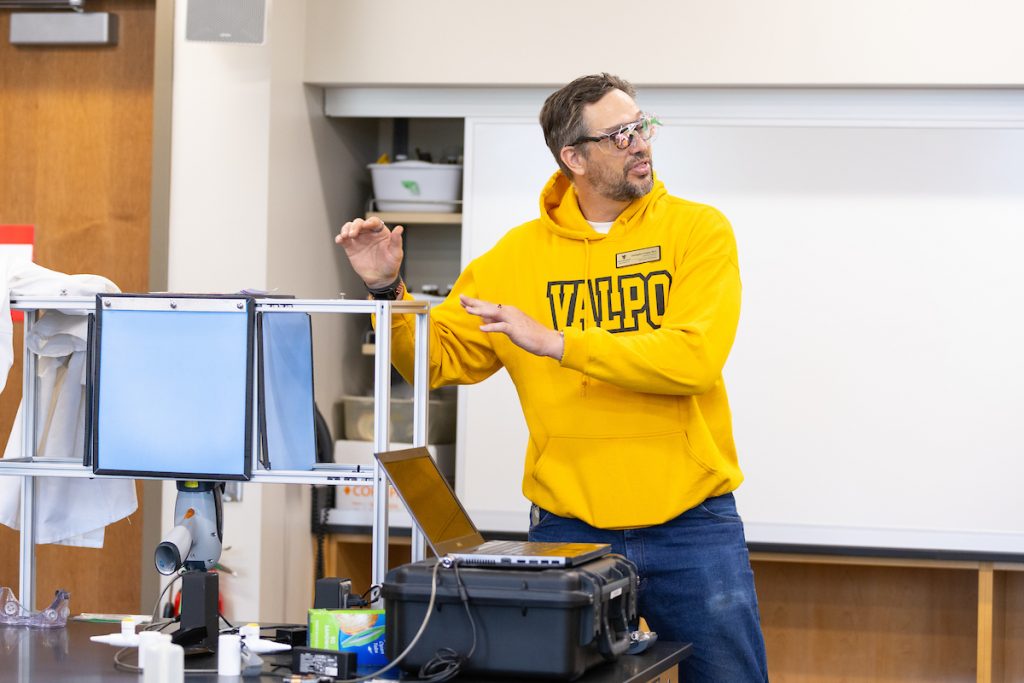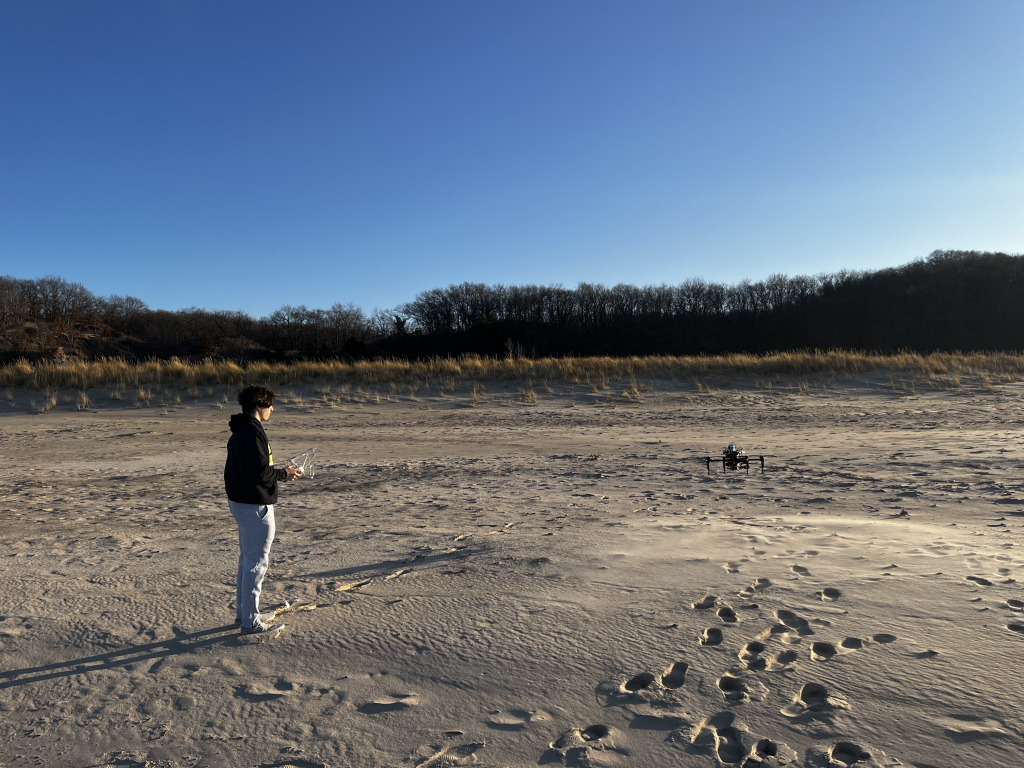Air, Industry, and Community Health
Most people ensure the food they eat hasn’t spoiled and the water they drink is clean, but how many give a second thought to the air they are constantly breathing? Researchers at Valparaiso University are working hard to ensure public safety by pushing the limits of technology designed to measure the number of particles in the air, finding out how much waste is being generated by industrial processes, and encouraging policy-makers to step up and make real changes.
The health consequences of the pollutants in the air, water, and soil from industrial waste can be varied and severe. Widespread respiratory issues are frequent, especially in the youth. The research of Chris Iceman, Ph.D., associate professor of chemistry at Valpo, has also found entire city blocks have developed particular kinds of cancer, and affordable housing projects built on land previously used for lead smelting, leading to the widespread breakup of homes and communities.
Professor Iceman, inspired by the technology NASA was planning to send to Mars, began the project several years ago with a grant from the Indiana Space Grant Consortium.
“They’re going to be flying around looking for molecules, but wouldn’t it be cool if we could do some testing of our own to see how good our air sensors work on a drone in our area?” Professor Iceman asked.
The key piece of technology for Professor Iceman and his students is an unassuming-looking purple box small enough to fit in the palm of your hand. This commercially available device for measuring air quality works via small fans that draw air into the casing. The air passes by a laser and, when particulate matter breaks the beam, a sensor measures the amount of scattered light, a measurement that correlates to the overall quality of the air.
Professor Iceman and his students have set up devices in a variety of areas in Northwest Indiana as part of the North Lake County Environmental Partnership, a coalition of higher education partners that monitor air quality, soil quality, and soil contamination. They have also zip-tied the sensors to drones, taking readings from high in the sky on Valpo’s campus, and at a national park near a steel manufacturing plant.
Abe Orozco Munoz ’25, a chemistry major from Chicago, joined the project after a conversation with Professor Iceman about available research opportunities. According to Abe, taking his classroom interests into the field and into a project that benefits the community has been a great experience.
“I like the integration of sciences where you can go into the lab, into the data, as well as outside helping the community and talking to people,” Abe says.
During the course of his work with Professor Iceman, Abe has earned standard airworthiness certification from the Federal Aviation Administration, signifying how a Valpo experience can lead to more skills than those gained from a standard curriculum.
In gathering and compiling their data, Professor Iceman and Abe have found some evidence that regional steel manufacturing is likely contributing to the pollutants in the air — an issue that Professor Iceman believes could mean significant trouble for the surrounding populations.
“We have a lot of knowledge about the main industries, which are very important to our national infrastructure, having emissions that exceed that of what their permits are for,” says Professor Iceman. “There are responsible ways to make steel, but less responsible ways create environmental injustice against the surrounding communities.”
Steel manufacturing isn’t the only local industry that could be contributing to air pollution. A power outage in Whiting, Indiana in February of 2024 led to British Petroleum burning off excess product — a practice that caused significant concern in the local community. Professor Iceman took on the task of installing an air quality sensor at city hall to monitor the impact of the event. Fortunately, the unseasonably warm weather allowed the smoke to rise and dissipate at a high altitude, but different circumstances could have led to a far different outcome.
“Had it been a really cold day, those smoke stacks would have dumped right back down on Northwest Indiana,” Professor Iceman says.
Ultimately, the goal of Professor Iceman’s project, and the related projects of his colleagues and partners across the region, is to influence policy-makers and ensure that products like steel and oil are being manufactured responsibly.
“I think what’s really fascinating about air quality is that it affects everybody,” says Professor Iceman. “It doesn’t matter if it’s two states over or on another continent. Eventually, it’s all going to come back to being everybody’s problem. I think there’s a lot of wisdom in thinking of this from a larger perspective.”
With that being said, creating major change is no easy task, and pointing fingers and assigning blame are unlikely to result in significant improvements. Professor Iceman recognizes the importance of these industries to the people of the region and the incredible impact they’ve had on the country, both historically and today, while still maintaining the need to keep the community safe.
“These are companies and industries that have literally built our country. Without them, we wouldn’t have railroads, we wouldn’t have skyscrapers, we wouldn’t have the ability to drive our cars the way we do,” Professor Iceman says. “But for these communities to face the fallout of that, that’s what we’re talking about when we talk about environmental justice. We’ve all benefited from these things, but when it comes down to who’s paying for them, it’s communities like ours across the country.”
For now, Abe and Professor Iceman will continue gathering data points, pushing for policy change, and — most importantly from a technical perspective — refining the use and determining the limits of their commercially-available air sensors. The current models, while proficient at detecting micron-sized contaminants, are proving unsuitable for painting a picture of the wide range of sizes that air pollutants can take.
“I would love to see our policy-makers support the idea that there should be some kind of local, regional, state, or national infrastructure of sensors that are good at measuring different kinds and sizes of particles,” says Professor Iceman.
For Abe, the goals of the project are the pursuit of environmental justice and spreading awareness around one of life’s most critical resources.
“Working on this project, I learned how underrepresented air quality is,” Abe says. “I feel like it’s not talked about as much as the other environmental areas. Air quality has such a great impact, and when we talk about food and water consumption, around 2-2.5 kilograms, we consume around 13 kilograms of air.”
Over the upcoming summer, Professor Iceman and his students continue to perform tests and gather data, and they will conduct health surveys in the region to understand what issues members of the community are facing. In the meantime, he urges everyone to stay aware of the air quality in their area and to bring up the issue with their local policy-makers.
“I believe that there are solutions,” says Professor Iceman. “There are ways to be a part of the industrial community and have it be a good thing from an environmental standpoint. I think it can happen if we all work together. But if we all sit on our hands and don’t do anything, then we’re left with what we have, and it’s going to stay the same or get worse.”



